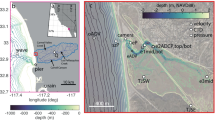Abstract
The flushing of Florida’s Indian River Lagoon is investigated as a response to tidal and low-frequency lagoon-shelf exchanges in the presence of freshwater gains and losses. A one-dimensional computer model uses the continuity equation to convert water-level variations into both advective transport within the lagoon and lagoon-shelf exchanges. The model also incorporates transport by longitudinal diffusion. Flushing is quantified by calculating the 50% renewal time, R50, for each of 16 segments. R50 is calculated for tidal exchanges enhanced by 0–30 cm nontidal fluctuations in coastal sea level, then for a range of rainfall rates. In both series of simulations, results suggest that in the northern sub-basin, R50 increases dramatically with distance from the inlet due to relatively weak tidal and nontidal exchanges. A 50% renewal occurs in about one tidal cycle just inside Sebastian Inlet; at the northern end of the northern sub-basin, R50 is over 230 d, and only coastal sea-level variations on the order of 30 cm and/or dry season rainfall rates decrease R50 to less than 1 yr. R50 is 1 wk or less throughout the central and southern sub-basins, where lagoon-shelf exchanges occur through two inlets. Simulations involving seasonal variations in precipitation and evaporation indicate that maximum and minimum rates of freshwater input lead minimum and maximum salinities by time periods on the order of 2–3 wk for the lagoon as a whole and in the northern sub-basin. The central and southern sub-basins respond in 1–2 wk.
Similar content being viewed by others
Literature Cited
Austin, G. B. 1954. On the circulation and tidal flushing of Mobile Bay, Alabama, Part 1. Department of Oceanography (Reference 54-20T), Texas A&M University, College Station, Texas. 63 p.
Chew, F. 1956. The probable lowest average salinity in the Indian River. Quarterly Journal of the Florida Academy of Sciences 19:241–250.
Dennis, R. E. and E. E. Long. 1971. A user’s guide to a computer program for harmonic analysis of data at tidal frequencies. National Oceanic and Atmospheric Administration Technical Report 41, United States Department of Commerce, Rockville, Maryland.
Dyer, K. and P. Taylor. 1973. A simple, segmented prism model of tidal mixing in well-mixed estuaries. Estuarine and Coastal Marine Science 1:411–418.
Glatzel, K. 1986. Water budget for the Indian River Lagoon: An overview of land use effects. M.S. Thesis, Department of Oceanography, Florida Institute of Technology, Melbourne, Florida. 109 p.
Glatzel, K. and S. Da Costa. 1988. Hydrology of the Indian River Lagoon. In Indian River Lagoon Estuarine Monograph, Marine Resources Council, Florida Institute of Technology, Melbourne, Florida.
Groves, G. 1955. Numerical filters for discrimination against tidal periodicities. Transactions, Americal Geophysical Union 36:1073–1084.
Haurwitz, B. and A. Cowley. 1975. The barometric tides at Zurich and on the summit of Santis. Pure and Applied Geophysics 113:355–364.
Ketchum, B. 1951. The exchanges of fresh and salt waters in tidal estuaries. Journal of Marine Research 10:18–38.
McDowell, D. M. and B. A. O’Connor. 1977. Hydraulic Behaviour of Estuaries. John Wiley & Sons, New York.
Merino, M., S. Czitrom, E. Jordan, E. Martin, P. Thome and O. Moreno. 1990. Hydrology and rain flushing of the Nichupte Lagoon system, Cancun, Mexico. Estuarine, Coastal and Shelf Science 31:223–237.
Miller, R. and B. McPherson. 1991. Estimating estuarine flushing and residence times in Charlotte Harbor, Florida, via salt balance and a box model. Limnology and Oceanography 36:602–612.
Pandit, A. and C. El-Khazen. 1990. Groundwater seepage into the Indian River Lagoon at Port St. Lucie. Florida Scientist 53:169–179.
Panofsky, H. and G. Brier. 1958. Some Applications of Statistics to Meteorology, 1st ed. Pennsylvania State University, University Park, Pennsylvania. 224 p.
Pore, N. and R. Cummings. 1967. A fortran program for the calculation of hourly values of astronomical tide and height of high and low water. Technical Memorandum TDL-6, National Weather Service, Silver Spring, Maryland. 127 p.
Pritchard, D. W. 1960. Salt balance and exchange rate for Chincoteague Bay. Chesapeake Science 1:48–57.
Rao, D. 1987. Surface water hydrology, Ch. 2. In J. Steward and J. VanArman (eds.), Indian River Lagoon Joint Reconaissance Report. St. Johns River Water Management District, Palatka, Florida.
Robinson, I. S. 1983. A tidal flushing model of the Fleet-An English tidal lagoon. Estuarine, Coastal and Shelf Science 16:669–688.
Schureman, P. 1958. Manual of harmonic analysis predictions of tides. Special Publication Number 98, revised edition, United States Goverment Printing Office, Washington, D.C. 317 p.
Sheng, Y. P., S. Peene, and Y. M. Liu. 1990. Numerical modeling of tidal hydrodynamics and salinity transport in the Indian River Lagoon. Florida Scientist 53:147–168.
Smith, N. P. 1986. The rise and fall of the estuarine intertidal zone. Estuaries 9:95–101.
Smith, N. P. 1987. An introduction to the tides of Florida’s Indian River Lagoon. I. Water levels. Florida Scientist 50:49–61.
Smith, N. P. 1993. Investigating the intertidal volume of Florida’s Indian River Lagoon. Florida Scientist 55:209–218.
Stommel, H. and A. B. Arons. 1951. A mixing length theory of tidal flushing. Transactions, American Geophysical Union 32:419–421.
Wood, T. 1979. A modification of existing simple segmented tidal prism models of mixing in estuaries. Estuarine and Coastal Marine Science 8:339–347.
Author information
Authors and Affiliations
Rights and permissions
About this article
Cite this article
Smith, N.P. Tidal and nontidal flushing of Florida’s Indian River Lagoon. Estuaries 16, 739–746 (1993). https://doi.org/10.2307/1352432
Received:
Accepted:
Issue Date:
DOI: https://doi.org/10.2307/1352432




